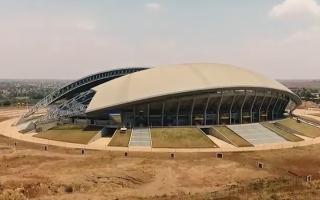Bingu National Stadium
| Capacity | 41 100 |
|---|---|
| Country | Malawi |
| City | Lilongwe |
| Clubs | - |
| Inauguration | 28/01/2017 (Be Forward Wanderers – Big Bullets, 2–1) |
| Construction | 11/07/2012 - 30/11/2016 |
| Design | BIAD (Beijing Institute of Architectural Design) |
| Contractor | Anhui Foreign Economic Construction Group |
Advertisement
Bingu National Stadium – stadium description
The promise of financing the new natinal stadium in Malawi came from China back in 2007, when the two countries officially signed their bilateral economic cooperation agreement. It was one of 5 major projects promised by the Chinese ambassador, to be located either in the capital Lilongwe or Blantyre. Eventually it was settled to be Area 48 i northern Lilongwe.
A total of 25.6 hectares were earmarked for the development, of which the stadium itself would hold construction area of 46,700 m2. From the very start it was clear that the stadium would be very economical, expected to cost MWK 26.6 billion. To secure the budget, China has lent $70 million to Malawi through it's export-import fund, to be repayed over 20 years.
It's a sum hard to believe for a stadium of 40,000 seats. It's thus no wonder that the Beijing-based BIAD supplied pre-done documentation of a stadium, while construction was done by Anhui Foreign Economic Construction Group, known for doing this kind of cheap stadium work in Costa Rica, Mozambique and Zambia as part of China's stadium diplomacy. To cheapen the project, any non-obligatory equipment, like electronic ticketing system, was scrapped and up to 900 workers were Chinese (total workforce of app. 2,000).
The stadium consists of two major areas, the first and largest being the reinforced-concrete stands, surrounded by vast, circular promenade. The seating bowl has two tiers along the west and east sides, divided by single strips of private boxes, 60 in total (2 presidential, 2 diplomatic and 56 other).
The second part is its vast roof, which – owed largely to low-rise housing of Lilongwe – became an instant landmark with its height of 56 meters. Based on four truss arches spanning 300 meters each, the roof is a typical feature of Chinese stadium designs exported to African countries. Beneath the roof there's room for all FIFA-required facilities as well as offices, a medical centre and two tanks holding up to 20,000 litres of rainfall water.
According to the Chinese ambassador, construction was due to end in 24 months, though eventual contract was signed for 29 months. While that could have been the case, there were a number of delays from the very start. After ceremonial cornerstone mounting in July of 2012 it took over a year to advance with foundations, which is when the actual construction began.
If counted from July of 2013, the project indeed took over 2 years, being ready for handover in late 2015. However, the Malawian authorities weren't ready for it, unable to connect the building with electricity grid or sewer system. Eventually it took over a year (!) to launch the stadium into operation in January, 2017.
Unfortunately the lack of readiness for a stadium of this scale didn't end there. Only 400 parking spaces exist around the stadium, which is accessible only through 2 narrow roads. This caused immense traffic and parking issues. Even worse, poor crowd management led to first tragedy just half a year into its operation. 8 people, 7 of them children, died in stampede at the gates during national holiday celebrations.
Advertisement
Pictures
-

24.12.2015 © Lars Plougmann (cc: by-sa) 
15.12.2016 © Homeline Media 
10.02.2017 © Peter Makawana 
10.02.2017 © Peter Makawana 
10.02.2017 © Peter Makawana 
10.02.2017 © Peter Makawana

 StadiumDB
StadiumDB
